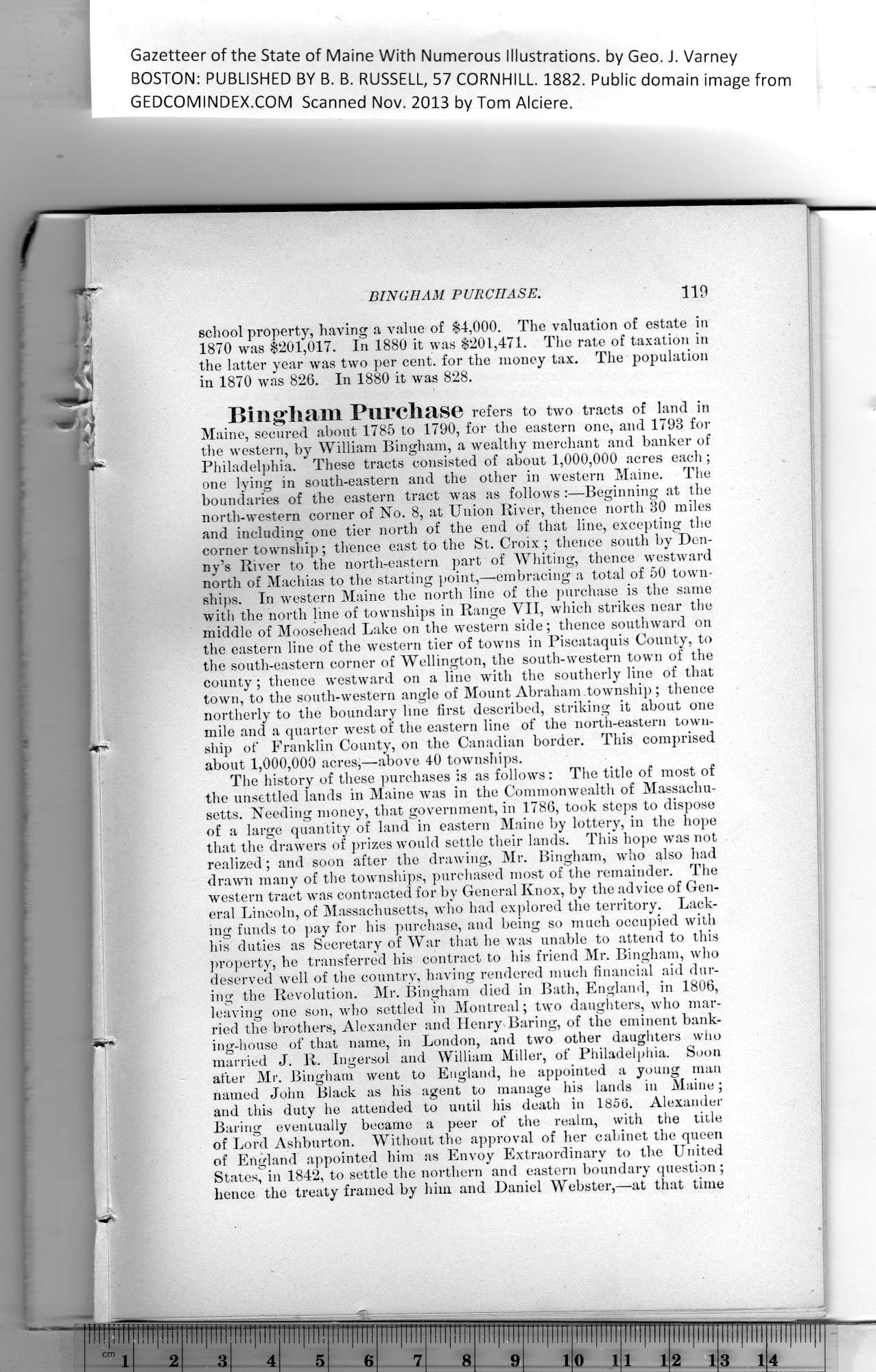|
Gazetteer of the State of Maine With Numerous Illustrations, by Geo. J. Varney
BOSTON: PUBLISHED BY B. B. RUSSELL, 57 CORNHILL. 1882. Public domain image from
%
BINGHAM PURCHASE.
school property, having a value of $4,000. The valuation of estate in
1870 was $201,017. In 1880 it was $201,471. The rate of taxation in
the latter year was two per cent, for the money tax. The population
in 1870 was 826. In 1880 it was 828.
Bing-ham Purchase refers to two tracts of land in
Maine, secured about 1785 to 1790, for the eastern one, and 1793 for
the western, by William Bingham, a wealthy merchant and banker of
Philadelphia. These tracts consisted of about 1,000,000 acres each ;
one lying in south-eastern and the other in western Maine. The
boundaries of the eastern tract was as follows :—Beginning at the
north-western corner of No. 8, at Union River, thence north 30 miles
and including one tier north of the end of that line, excepting the
corner township; thence east to the St. Croix ; thence south by Den-
ny’s River to the north-eastern part of Whiting, thence westward
north of Machias to the starting point,—embracing a total of 50 town-
ships. In western Maine the north line of the purchase is the same
with the north line of townships in Range VII, which strikes near the
middle of Moosehead Lake on the western side; thence southward on
the eastern line of the western tier of towns in Piscataquis County, to
the south-eastern corner of Wellington, the south-western town of the
county; thence westward on a line with the southerly line of that
town,To the south-western angle of Mount Abraham township ; thence
northerly to the boundary line first described, striking it about one
mile and a quarter west of the eastern line of the north-eastern town-
ship of Franklin County, on the Canadian border. This comprised
about 1,000,000 acres,—above 40 townships.
The history of these purchases is as follows: The title of most of
the unsettled lands in Maine was in the Commonwealth of Massachu-
setts. Needing money, that government, in 1786, took steps to dispose
of a large quantity of land in eastern Maine by lottery, in the hope
that the drawers of prizes would settle their lands. This hope was not
realized; and soon after the drawing, Mr. Bingham, who also had
drawn many of the townships, purchased most of the remainder. The
western tract was contracted for by General Knox, by the advice of Gen-
eral Lincoln, of Massachusetts, who had explored the territory. Lack-
ing funds to pay for his purchase, and being so much occupied with
his duties as Secretary of War that he was unable to attend to this
property, he transferred his contract to his friend Mr. Bingham, who
deserved well of the country, having rendered much financial aid dur-
ing the Revolution. Mr. Bingham died in Bath, England, in 1806,
leaving one son, who settled in Montreal; two daughters, who mar-
ried the brothers, Alexander and Henry Baring, of the eminent bank-
ing-house of that name, in London, and two other daughters who
married J. R. Ingersol and William Miller, of Philadelphia. Soon
after Mr. Bingham went to England, he appointed a young man
named John Black as his agent to manage his lands in Maine;
and this duty he attended to until his death in 1856. Alexander
Baring eventually became a peer of the realm, with the title
of Lord Ashburton. Without the approval of her cabinet the queen
of England appointed him as Envoy Extraordinary to the United
States, in 1842, to settle the northern and eastern boundary question;
hence the treaty framed by him and Daniel Webster,—at that time
PREVIOUS PAGE ... NEXT PAGE
This page was written in HTML using a program written in Python 3.2
|
